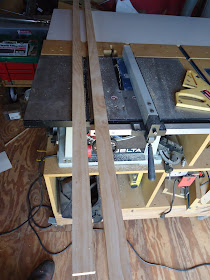Before I got serious with motorcycles and kids, I used to do a fair bit of woodworking and furniture building. I think my last major projects were a crib and swingset. At any rate co-worker of my wife is retiring from the civil service side of the Air Force. The Air Force coin has a long history and the units this gentlemen have supported sent in like 30 coins. So a proper display was needed. We couldn't find what we wanted so we had to build it. Of course it was short notice so I had to cheat a bit.
I started with a basic hinged door display from Hobby Lobby. My other friend took it to a glass shop and had mirror put into the back of it. The mirror will look great in use, but will make my pictures of the build a little tricky for sure.

Measure the depth for the shelves.

When you have cheap bench saw with cheap fence you need a square to set it up properly.

Cheating again, I bought the nice pine board that was sanded smooth already. That will save me more time in the end. Always use push boot with a table saw.

One 1X4 will rip down to two shelf boards.

Measure the width.

Cut those to length on the miter saw.

Fitting good.

Make a few spares, too.

Now to figure out the spacers to hold the new shelves.

Yeah, I tried and tried to figure out how to get those shelves evenly spaced. I should have used a CAD program or something, maybe in was the 105° heat in my shed, but the math never worked out one shelf is just a bit different.


The spacing looks okay though, but ...

I don't like the width of the spacers at all.

Set the saw to rip them in half again.

I started with a fresh board for safety sake.

Now it's shaping up.

I didn't like the bottom shelf height so I ripped it narrower and cut the last shorter spacer.

Matching the finish on the prebuilt box is going to be a trick. I played with a couple of methods and finishing black spray paint and flat clear spray seemed to match up pretty well.

Now to cut the coin slots. I tilted the blade a bit and had to make two passes get the width right. Notice the shim on the fence to get the cut offset just a bit.

It left a little in the middle, that was easy to knock out.

Test fit.

All cut and ready for paint. The presanded boards helped a bunch here.


All together and looking good.























































